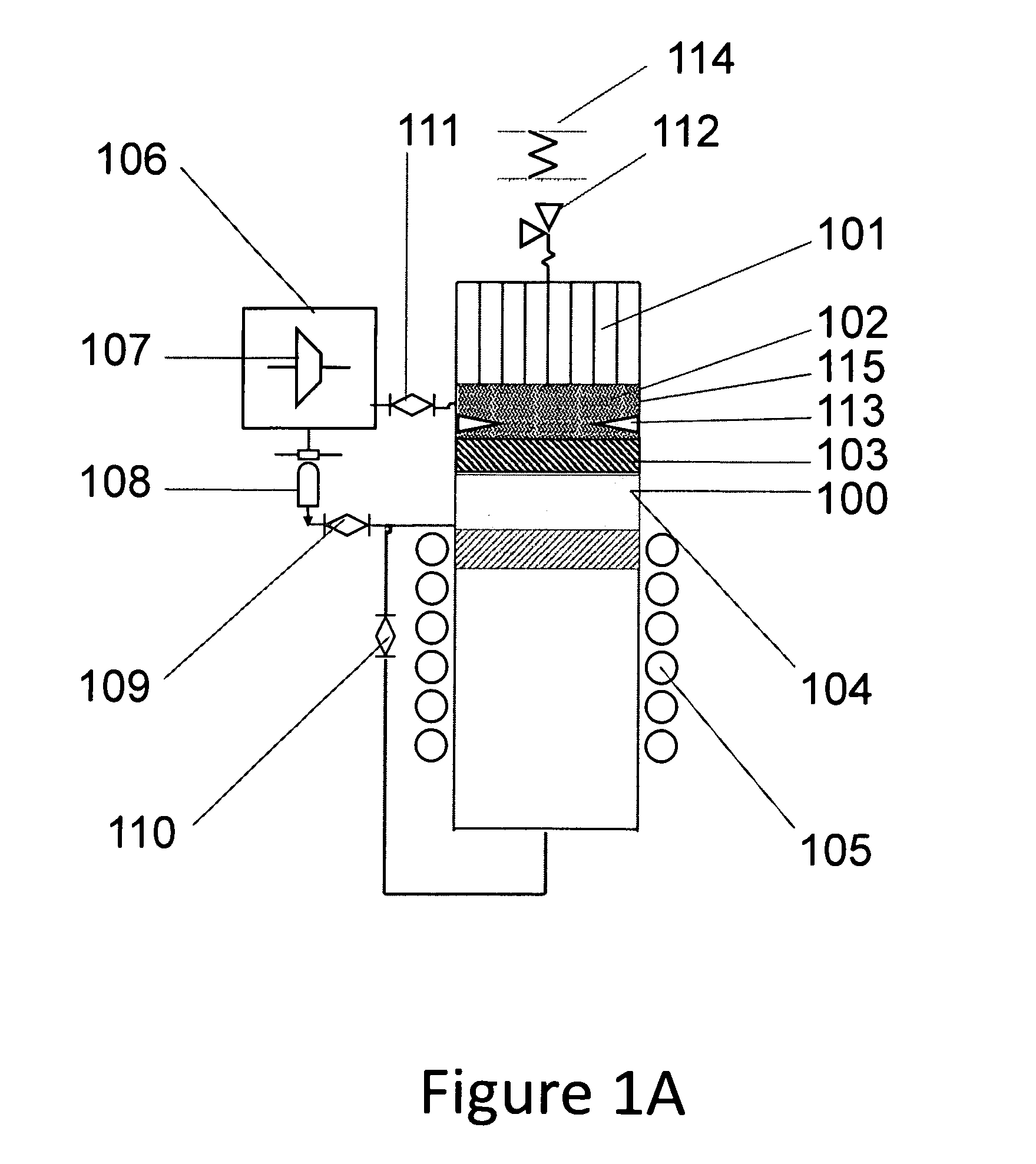Methods of pulsed nuclear energy generation using piston-based systems
a technology of pulsed nuclear energy and piston-based systems, which is applied in the direction of marine propulsion, vessel construction, greenhouse gas reduction, etc., can solve the problem of high power production per volume of engine, and achieve the effect of high heat transfer rate, high heat transfer coefficient and high surface heat exchang
- Summary
- Abstract
- Description
- Claims
- Application Information
AI Technical Summary
Benefits of technology
Problems solved by technology
Method used
Image
Examples
embodiment 1
[0045]In the embodiment 1 according to FIG. 1A, the system comprises the heating element 101, metallic or ceramic cylinder 100 housing the heating element 101 on its “hot end”, “cold end”, opposite to the hot end, piston 103, beryllium neutron reflectors 104, electromagnetic alternator 105, condenser 106, a turbo-expander 107, fluid accumulator with an optional heat-exchanger 108, an exhaust valve 111, an inlet valve 109, a drain valve 110, a safety valve 112, piston restrictors 113, shock absorbers 114. Other elements known in the art are not shown but will be discussed when necessary. Relative to the direction of gravity force, the heating zone is on the top of the cylinder and the piston approaches it from below to trigger a new cycle. The reason for such orientation of the heaters is thermodynamic efficiency. This parameter will be improved if the entire mass of the condensed moderator is introduced in the heating zone and thus creates a small volume of high pressure steam. Plac...
embodiment 2
[0053]FIG. 3.A presents the parts of the embodiment 2. 101 is the nuclear heat source, 209 is inner reaction vessel, 208 is working space, occupied by vapors of the water-immiscible working fluid (pentane, butane), condenser 204. The parts 205, 206, 207 are parts of a low-density floating piston, lighter than water 210 but heavier than working fluid 211, with a layer of neutron reflector 207 built in and located in horizontal plane, 205 being a heat-insulating light-weight material and 206 being a structural plate. 203 is a hydraulic turbine, 201 is an annular reservoir, a ceramic water impervious construct coaxial and in hydraulic contact with 209.
[0054]The gas expansion caused by the evaporation brings into motion a column of water through a hydraulic turbine (FIG. 3B, stage A). The turbine is rotated again when the evaporated steam is condensed and the water levels off, taking the starting position (FIG. 3B, stage B). The attractive side of the process is its simplicity, and econ...
embodiment 3
[0057]FIG. 4A shows the parts of the embodiment 3 also termed “steam gun”. In this approach the system comprises (FIG. 4A) the heating element 101, metallic or ceramic cylinder 100 housing the heating element 101 on its “hot end”, “cold end”, opposite to the hot end, piston 103, beryllium neutron reflectors 104, electromagnetic alternator 105, a drain valve 110, a safety valve 112, piston restrictors 113, shock absorbers 114. Other elements known in the art are not shown but will be discussed when necessary. Relative to the direction of gravity force, the heating zone is on the top of the cylinder and the piston approaches it from below to trigger a new cycle. The element 301 (condensation space) differentiates this embodiment with the embodiment 1 as well as the absence of the valves 109 and 110. The gas expansion proceeds in four steps: a) evaporation of working fluid b) overheating c) adiabatic expansion until saturation d) isentropic expansion of the saturated vapor in the same ...
PUM
 Login to View More
Login to View More Abstract
Description
Claims
Application Information
 Login to View More
Login to View More - R&D
- Intellectual Property
- Life Sciences
- Materials
- Tech Scout
- Unparalleled Data Quality
- Higher Quality Content
- 60% Fewer Hallucinations
Browse by: Latest US Patents, China's latest patents, Technical Efficacy Thesaurus, Application Domain, Technology Topic, Popular Technical Reports.
© 2025 PatSnap. All rights reserved.Legal|Privacy policy|Modern Slavery Act Transparency Statement|Sitemap|About US| Contact US: help@patsnap.com



